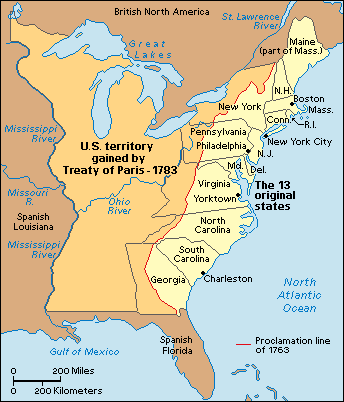For the first 250 years of the European invasion, colonists from France, Britain, Holland, and Spain settled along the ocean shores and various rivers from the moment they landed, with little consideration for the Indigenous people already living there. While the First Nations people initially helped the settlers and even had reasonable trading relationships with them, conflicts soon developed over competition for land. In 1763, after the end of the Seven Years War, the French were out of North America and Britain was in control of all lands east of the Mississippi and as far north as Hudson's Bay. To try and end the murderous conflict between settlers and First Nations, the British king, George III, issued a proclamation that set aside land for the Indians. A line was drawn along the Appalachian Mountains that forbid any settlement to the west which was delineated Indian Territory, and it went all the way to the Mississippi River which formed the eastern border of the Spanish territory.
The next group of treaties to be signed were the Lake Superior and Lake Huron Robinson Treaties in 1850. Beginning in the 1840's various mining companies had sent prospectors and surveyors into unceded territory to identify potential mineral deposits. They then acquired licenses from the colonial government to mine the region in spite of not having a treaty that surrendered the lands. The Abishnawbe protested and demanded compensation and, after a violent clash erupted between miners and First Nation warriors, William Robinson was dispatched to negotiate a treaty and buy up land. One time payments and annual annuities were agreed to and huge tracts of land were surrendered. First Nations were also granted the right to hunt and fish in the treaty territory as long as there weren't any settlements or mining operations in place and land for reserves was also set aside. Despite the fact the annual annuity payments were never were adjusted over the next 200 years and are now the subject of a lawsuit, Indigenous land claims once again were confirmed.
After confederation, in 1867, the newly formed Confederation of Canada looked to expand its borders from sea to sea. Even though the government had acquired the former Rupert’s Land (the entire Hudson Bay drainage system that had been granted to the HBC 200 years earlier) they failed to have full control and use of the land as this transfer only provided sovereignty over the area. Title had reverted to the First Nations living there. One of the conditions to ensure British Columbia would join Confederation at the time was the construction of the Canadian Pacific Railway which would connect it to the rest of the nation. In order to satisfy British Columbia's request and the growing need for land by eastern settlers and new immigrants, treaties would have to be created with the First Nation people in the interior of the newly acquired land, which was all First Nation territory.
The Numbered Treaties are a series of eleven treaties signed between the First Nations and Canada from 1871 to 1921. These treaty agreements were created to allow the Government of Canada to pursue settlement and resource extraction in the affected regions, which include modern-day Alberta, Saskatchewan, Manitoba, and parts of Ontario, B.C. and the Northwest Territories.
These treaties came in two waves—Numbers 1 through 7 from 1871 to 1877 and Numbers 8 through 11 from 1899 to 1921. In the first wave, the treaties were key in advancing European settlement across the Prairie regions as well as the development of the CPR. In the second wave, resource extraction was the main motive for government officials.
In these treaties, the First Nations were coerced and tricked into giving up aboriginal title to vast
amounts of land, in exchange for small reserves for their exclusive use and various promises
of schools, food, and farming assistance as well as other entitlements such as
hunting and fishing rights. Unfortunately none of these treaty terms were ever completely adhered to but the fiction of recognizing First Nations ownership was maintained.
When the Colony of British Columbia joined Confederation, in 1871, it did not recognize Indigenous title so it felt there was no need for treaties and, other than the Douglas Treaties and Treaty 8 signed by the Federal government to resolve problems related to the Klondike Gold Rush, treaties were not signed with any First Nations for the rest of British Columbia. With most of B.C. now considered unceded land, this was clearly both a mistake and a shorted sighted strategy. In 2000, the historic Nisga'a Treaty went into effect and set a precedent in forcing the issue of unrecognized Aboriginal title. This has resulted in over 50 other Indigenous nations in B.C. now negotiating agreements at various stages of the treaty making process.
.jpg)








No comments:
Post a Comment